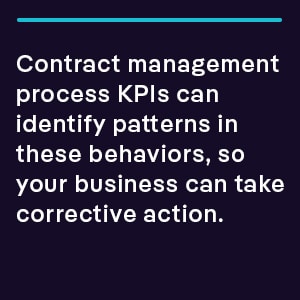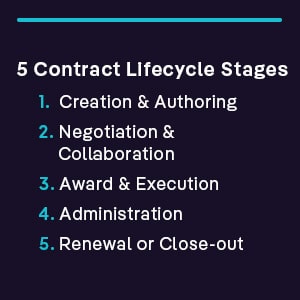The quote “If you can’t measure it, you can’t improve it.” is often attributed to Austrian management consultant Peter Drucker and also to statistician W. Edwards Denning. The statement certainly rings true for business agreements. If organizations don’t keep track of their contract lifecycle management (CLM) metrics, they can’t keep track of circumstances like negotiation cycles getting longer, contract costs increasing, or vendor reliability waning.
Of course, these CLM circumstances could be better than ever, yet if you don’t have the processes or technology in place to measure them, your organization won’t know:
- To keep negotiating sales or procurement agreements as they are
- To keep contract expenses down
- To maintain their existing vendor relationships
What contract lifecycle management metrics should your organization measure? What key performance indicators (KPIs) should be prioritized, and what tools are best to monitor them? The answers to these questions are just ahead.
So to help you better understand and navigate the contract lifecycle management (CLM) market, we came up with a handy list of ‘must-haves.’ The following are the most important features you should look for in contract management software right now.
Types of Contract Lifecycle Management KPIs
Process

Ensuring your legal team and their cross-functional colleagues adhere to your company’s contract management processes and policies is vital. For example, new salespeople might not get the required sales price approvals or signed purchase requisitions before trying to put a customer or supplier order through. On the other side of the coin, executives may take too long to approve these transactions and require a workflow escalation or intervention.
Contract management process KPIs can identify patterns in these behaviors, so your business can take corrective action. It might just require a coaching conversation to set things on the right track again. Having reports and concrete statistics provides irrefutable proof of what needs to be changed, and why.
Efficiency
If you were put on the spot, could you find out, even approximately how long your negotiations take from start to signature? Could you get your hands on the value of professional services statements of work (SOWs) at signing, and how much money is left on the table due to poorly scoped deliverables? Are you failing to build enough contingency into fixed-price contracts, and your consultants are still writing code when they should be completing user testing?
Contract efficiency analysis can help your management team to identify where your contracts, operations, and project managers need to make adjustments in their estimates. You can also track how efficiently the outside vendors and suppliers you do business with are living up to their obligations.
Performance
Identifying that your service contracts aren’t being renewed, obligations are missed, or contracts are terminated early are all signs that there are performance challenges throughout your business. Contract risk analytics (when programmed with the right parameters) can identify and alert contract managers or designated executives that they need to get to the root causes of contract performance deficiencies.
Top CLM Metrics You Should Track
Now that we have identified the types of CLM categories that exist, you will need to understand the specific types of metrics you should monitor to ensure your contract affairs are in order.
The most advanced contract management software helps you do all of that. Through an intuitive dashboard, you can gain a holistic view of deals across the enterprise. And through advanced, customizable reporting, you can keep up to date on the contractual details and analyze real-time contract data. You can assess the progress of your contract lifecycles, too, and figure out what changes you need to make along the way. In other words, these contract management features allow you to see the overall impact of your contracting, so that you can identify and mitigate risk.
Contract Efficiency
Contract efficiency metrics are, strangely enough, efficiency metrics. Understanding how long complete contract lifecycles take from start to finish requires careful consideration of the time and the agility contracts go through these stages: 
- Creation and authoring
- Negotiation and collaboration
- Award and execution
- Administration
- Renewal or close-out
There are some factors that impact contract efficiency that are (or seem to be) out of a company’s control. For example, the complexity of a purchase—especially during a competitive process—can draw out the negotiation and award stages. Yet businesses that are efficient with other CLM phases can earn the trust and goodwill of their negotiation partner, creating a more collaborative process.
Contract Effectiveness
If your company is meeting your contract obligations, milestones, and contract volume targets, your contract effectiveness metrics will be high. As a performance metric, this KPI will rely on your contract management office to write concise contract terms, and on your project or project manager to help deliver them as promised.
Contract Value
Meeting contract value performance metrics doesn’t end when a contract is signed by both parties. A business has to fulfill its contractual obligations as a supplier or service provider and minimize contract value erosion. Aim to create clearly written contracts that include input from all of the necessary stakeholders from each business that is a party to the agreement.
Contract Risk
Commercial contracts generally carry a considerable amount of financial implications, making risk an important contract management benchmark. Contract risk indicators help contract managers monitor and measure every aspect of an agreement — and the risk of financial loss — throughout the contract management process.
Unrenewed or unfulfilled contracts are a strong indicator that a company could be headed toward a financial cliff. Not being on top of these risk factors can mean it’s too late to change course before your company is forced to downsize, make personnel changes, or worse.
The Role of Contract Management Metrics
It is often said that contract revenue is the lifeblood of companies of all sizes. Contract management metrics are indicators of the immediate and long-term health and viability of your business. When KPIs like contract effectiveness, value, and efficiency are trending positively, your company’s fortunes will follow. Otherwise, your legal team needs to take corrective steps toward turning those metrics around.
Those steps may include making your contract language simpler for new customers or renewals. Or they can focus on making contract negotiations more collaborative.
How to Choose the Right Metrics
Choose the contract lifecycle management metrics that align with your business goals, and matter most to you, and your negotiation partners. For example, some industries like high tech and telecommunications prioritize contract value. Other organizations in industries like insurance, healthcare, or financial services may be more concerned with mitigating risk, or contract renewals.
Organizations in regulated industries like the latter three above are concerned about contract risk and value, and they want to ensure their performance metrics reporting is as thorough and transparent as possible for compliance purposes.
Who Keeps Track of These CLM Metrics?
The legal department certainly keeps watch on metrics like risk, renewals, and any that might result in litigation. For example, contract effectiveness metrics like milestones or obligations met or missed. The finance, investor relations, procurement, and sales departments have different interests in contract value performance. Many stakeholders in the operations department would track supplier performance against their obligations.
It is realistic to say that many executives and employees should keep track of contract lifecycle management metrics. It is up to organizations like yours to establish the best ways to distribute that information.
If you want to learn even more about these contract lifecycle management metrics you should be tracking, check out our Primer, which includes another handy contract management checklist. And to see how you can start your legal digital transformation, contact us today to request a demo.


